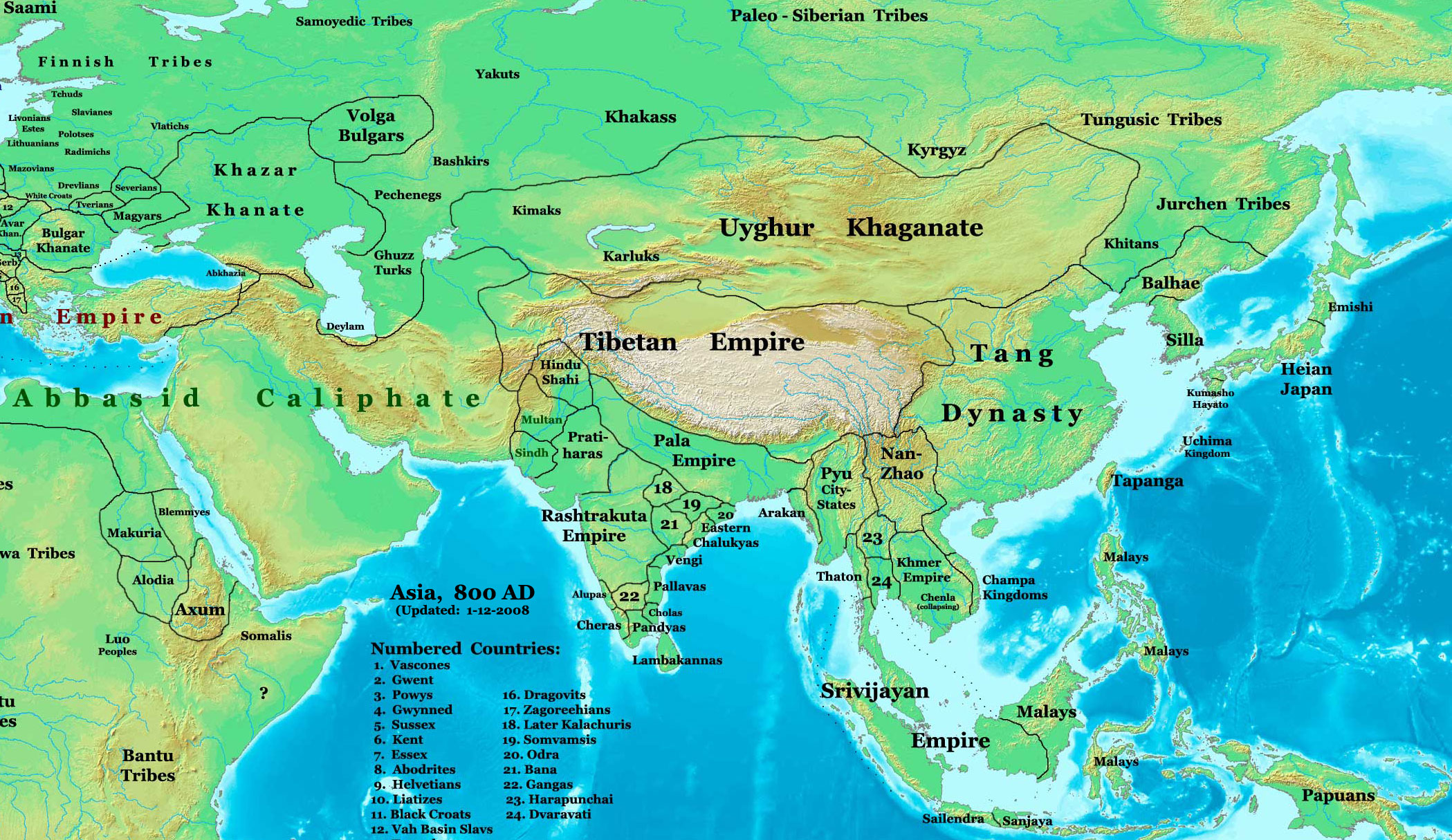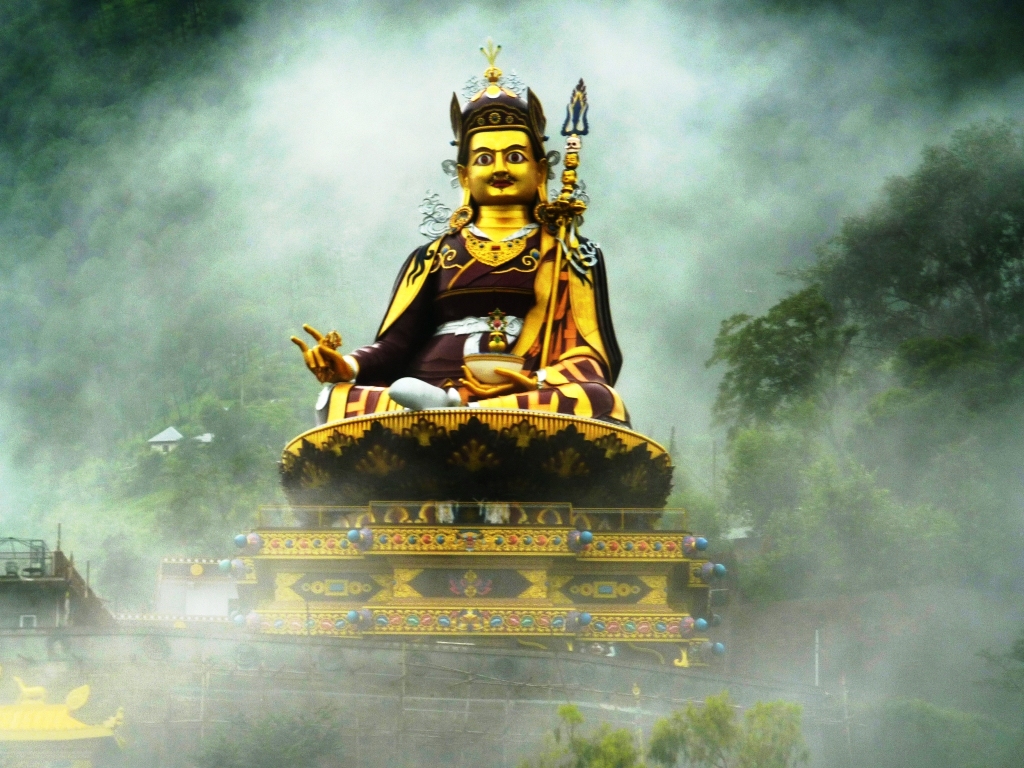|
Tibetan Monasticism
Although there were many householder-yogis in Tibet, monasticism was the foundation of Buddhism in Tibet. There were over 6,000 monasteries in Tibet. However, nearly all of these were ransacked and destroyed by Red Guards during the Cultural Revolution. Most of the major monasteries have been at least partially re-established, while many others remain in ruins. Mongolian Buddhism derives from the Gelug school of Tibetan Buddhism. In Mongolia during the 1920s, approximately one third of males were monks, though many lived outside monasteries. By the beginning of the 20th century about 750 monasteries were functioning in Mongolia. These monasteries were largely dismantled during Communist rule, but many have been reestablished during the Buddhist revival in Mongolia which followed the fall of Communism. Monasteries generally adhere to one particular school. Some of the major centers in each tradition are as follows: Nyingma lineage is said to have "six mother monasteries" each of ... [...More Info...] [...Related Items...] OR: [Wikipedia] [Google] [Baidu] |
Mindrolling Monastery
Mindrolling Monastery (, English: "Sublime Island of Ripening Liberation"), is one of the "Six Mother Monasteries" of the Nyingma school in Tibet. It was founded by Rigzin Terdak Lingpa in 1676. Tendrak Lingpa's lineage is known as the ''Nyo'' lineage. The name in Tibetan means "Place of Perfect Emancipation". It is located in Zhanang County, Shannan Prefecture, Tibet Autonomous Region, China, known as U-Tsang. Mindrolling Monastery is approximately 43 kilometers east of the Lhasa airport, on the south side of the Tsangpo river. History Mindrolling was heavily damaged in 1718 by the Dzungar Mongols from East Turkistan. It was rebuilt during the reign of the Seventh Dalai Lama (1708–1757). Dungsay Rinchen-namgyel and Jetsunma Mingyur Paldron, the son and daughter of Terdak Lingpa, supervised its reconstruction. For nearly 300 years its monastic university trained Nyingma scholars and yogis from all over Tibet. At Mindrolling, special emphasis was placed on the learning ... [...More Info...] [...Related Items...] OR: [Wikipedia] [Google] [Baidu] |
Palpung Monastery
Palpung Monastery () is the name of the congregation of monasteries and centers of the Tai Situpa lineage of the Kagyu school of Tibetan Buddhism as well as the name of the Tai Situ's monastic seat in Babang, Kham (modern Sichuan). Palpung means "glorious union of study and practice". It originated in the 12th century and wielded considerable religious and political influence over the centuries. The current monastery was founded in 1727 by the 8th Tai Situpa "Situ Panchen" with the great support of the Dharma King of Derge Temba Tsering. It is the seat of four lines of incarnate lamas, the best-known being the Tai Situpa as well as the Jamgon Kongtrul and the Second Beru Khyentse. The temple has historically been associated with the Karmapas: for instance, Rangjung Rigpe Dorje, 16th Karmapa, was enthroned first at Palpung before traveling to his main seat at Tsurphu Monastery in Ü-Tsang. The 12th Tai Situpa, Pema Tönyö Nyinje, has established a new monastic seat in exile at P ... [...More Info...] [...Related Items...] OR: [Wikipedia] [Google] [Baidu] |
Kagyu
The ''Kagyu'' school, also transliterated as ''Kagyü'', or ''Kagyud'' (), which translates to "Oral Lineage" or "Whispered Transmission" school, is one of the main schools (''chos lugs'') of Tibetan (or Himalayan) Buddhism. The Kagyu lineages trace themselves back to the 11th century Indian Mahasiddhas Naropa, Maitripa and the yogini Niguma, via their student Marpa Lotsawa (1012–1097), who brought their teachings to Tibet. Marpa's student Milarepa was also an influential poet and teacher. The Tibetan Kagyu tradition gave rise to a large number of independent sub-schools and lineages. The principal Kagyu lineages existing today as independent schools are those which stem from Milarepa's disciple, Gampopa (1079–1153), a monk who merged the Kagyu lineage with the Kadam tradition. The Kagyu schools which survive as independent institutions are mainly the Karma Kagyu, Drikung Kagyu, Drukpa Lineage and the Taklung Kagyu. The Karma Kagyu school is the largest of the sub-schoo ... [...More Info...] [...Related Items...] OR: [Wikipedia] [Google] [Baidu] |
Lamas Rumtek
Lamas may refer to: * the plural form of Lama, a title for a teacher of the Dharma in Tibetan Buddhism. Places *Lamas Province, Peru **Lamas District **Lamas, Peru, the capital of Lamas Province and seat of Lamas District *Lamas (Braga), a parish in Braga District, Portugal *Lamas (Cadaval), a parish in Cadaval Municipality, Lisbon District, Portugal *Lamas (Miranda do Corvo), a parish in Miranda do Corvo Municipality, Coimbra District, Portugal *Lamas (Macedo de Cavaleiros), a parish in Macedo de Cavaleiros Municipality, Bragança District, Portugal *Santa Maria de Lamas, a parish in Aveiro District, Portugal *Lamas, Norfolk, a village in England Other uses *Lamas (surname) *Lamas Quechua, a variety of Quechuan language *London and Middlesex Archaeological Society (LAMAS) See also *Lama (other) *Lammas Lammas Day (Anglo-Saxon ''hlaf-mas'', "loaf-mass"), also known as Loaf Mass Day, is a Christian holiday celebrated in some English-speaking countries in the North ... [...More Info...] [...Related Items...] OR: [Wikipedia] [Google] [Baidu] |
Śāntarakṣita
(Sanskrit; , 725–788),stanford.eduŚāntarakṣita (Stanford Encyclopedia of Philosophy)/ref> whose name translates into English as "protected by the One who is at peace" was an important and influential Indian Buddhist philosopher, particularly for the Tibetan Buddhist tradition . Śāntarakṣita was a philosopher of the Madhyamaka school who studied at Nalanda monastery under Jñānagarbha, and became the founder of Samye, the first Buddhist monastery in Tibet. Śāntarakṣita defended a synthetic philosophy which combined Madhyamaka, Yogācāra and the logico-epistemology of Dharmakirti into a novel Madhyamaka philosophical system .Blumenthal (2018) This philosophical approach is known as ''Yogācāra-Mādhyamika'' or ''Yogācāra-Svatantrika-Mādhyamika'' in Tibetan Buddhism. Unlike other Madhyamaka philosophers, Śāntarakṣita accepted Yogācāra doctrines like mind-only (''cittamatra'') and self-reflective awareness (''svasamvedana''), but only on the level of co ... [...More Info...] [...Related Items...] OR: [Wikipedia] [Google] [Baidu] |
Padmasambhava
Padmasambhava ("Born from a Lotus"), also known as Guru Rinpoche (Precious Guru) and the Lotus from Oḍḍiyāna, was a tantric Buddhist Vajra master from India who may have taught Vajrayana in Tibet (circa 8th – 9th centuries)... According to some early Tibetan sources like the ''Testament of Ba'', he came to Tibet in the 8th century and helped construct Samye Monastery, the first Buddhist monastery in Tibet. However, little is known about the actual historical figure other than his ties to Vajrayana and Indian Buddhism. Padmasambhava later came to be viewed as a central figure in the transmission of Buddhism to Tibet. Starting from around the 12th century, hagiographies concerning Padmasambhava were written. These works expanded the profile and activities of Padmasambhava, now seen as taming all the Tibetan spirits and gods, and concealing various secret texts ('' terma'') for future tertöns. Nyangral Nyima Özer (1124–1192) was the author of the ''Zangling-ma'' (Jew ... [...More Info...] [...Related Items...] OR: [Wikipedia] [Google] [Baidu] |
Samye
Samye (, ), full name Samye Mighur Lhundrub Tsula Khang (Wylie: ''Bsam yas mi ’gyur lhun grub gtsug lag khang'') and Shrine of Unchanging Spontaneous Presence is the first Tibetan Buddhist and Nyingma monastery built in Tibet, during the reign of King Trisong Deutsen. Shantarakshita began construction around 763, and Vajrayana founder Guru Padmasambhava tamed the local spirits for its completion in 779. The first Tibetan monks were ordained there. Samye was destroyed during the Cultural Revolution then rebuilt after 1988. Samye Monastery is located in the Chimpu valley (''Mchims phu''), south of Lhasa, next the Hapori mountain, in the Yarlung Valley. The site is in the present administrative region of Gra Nang or Drananga Lhoka. History According to the Blue Annals, completed in 1476, the temple was constructed between 787 and 791 under the patronage of King Trisong Detsen. Earlier in date is the Testament of Ba, the oldest account of the construction of the temple. This reco ... [...More Info...] [...Related Items...] OR: [Wikipedia] [Google] [Baidu] |
Shechen Monastery
Shechen Monastery () is one of the "Six Mother Monasteries" of the Nyingma tradition of Tibetan Buddhism. It was originally located in Kham, Tibet, but was destroyed in the late 1950s during the Cultural Revolution and was rebuilt in Nepal in 1985. History The original Shechen Monastery was located southwest of Langduo Township in Kham on the route to Dzogchen Monastery in what is now Dêgê County, Garzê Prefecture, Sichuan, China. It was founded in 1695 by Shechen Rabjam Tenpé Gyaltsen, though it is sometimes claimed to have been built by Gyurme Kunzang Namgyal in 1734. It became extremely influential in the 18th and 19th centuries, with up to 160 satellite monasteries dotting the hillsides. The monastery was destroyed in the 1950s as part of the Communist Chinese government's Cultural Revolution. In the 1980s, Dilgo Khyentse Rinpoche transplanted the rich tradition of the original Shechen Monastery to a new home near the great Stupa of Bodhnath in Kathmandu, Nepal. Sh ... [...More Info...] [...Related Items...] OR: [Wikipedia] [Google] [Baidu] |
Palyul
Palyul Monastery (), also known as Palyul Namgyal Jangchub Choling Monastery and sometimes romanized as Pelyul Monastery, is one of the "Six Mother Monasteries" of the Nyingma tradition of Tibetan Buddhism. It was founded in 1665 by Rigzin Kunzang Sherab in Dege, on the eastern edge of Tibet in Kham, a town in today's Baiyü County, Garzê Tibetan Autonomous Prefecture in China's Sichuan province. The monastery is the seat of the Nam Chö Terma of Terton Migyur Dorje. Drubwang Padma Norbu (Penor Rinpoche) was the 11th throneholder of the Palyul lineage. Upon his mahaparinirvana in March, 2009, Karma Kuchen Rinpoche became the 12th throneholder. Namdroling Monastery in Bylakuppe, India, is where the current throneholder to the Palyul lineage has resided since exile from Tibet during Chinese annexation. Dzogchen Lineage of Palyul * Chöku Kuntuzangpo ( Dharmakaya Samantabhadra) * Drugpa Dorjé Changchen (Vajradhara) * Dorje Sempa (Vajrasattva) * Thugjé Chenpo Chenrezig ( ... [...More Info...] [...Related Items...] OR: [Wikipedia] [Google] [Baidu] |





